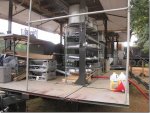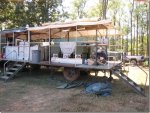- 5,361
- 3,361
- 113
- Location
- Lexington, South Carolina
After washing the cookware in cold water by lantern light at my first Georgia Rally, standing on muddy ground, I vowed there should be a better way.
I picked up a partially stripped MKT and began the build. First I cut down the cabinet that the four burners sit on and shortened it so that it would hold three burners under the three sinks (wash, rinse, and sanitize). Because I knew I (or anyone else 'doing dishes') the height was such that the front lip of the sinks just fit over the round rail on the side, with the sinks facing outward. This resulted in the plumbing and the grease trap being in the center aisle, but it also gave me a storage area for extra MBU's, the drain table, a couple of field tables, a folding chair, and a trash can to store supplies in. The ladders and rails are also stored there during transport. The drying racks are simply chrome plated steel wire shelving with the accessory short back and end walls from Global Supply (they are a common item, that's just who I used). Because we were brewing our own tea at the time (10 gallons in a batch), I installed an M-59 range in the back left corner just for that purpose. Because the sinks were set foward the drain table would not fit on the end of the third sink as the military intended - it needed to be offset about four inches to the rear. Hacksaw to the rescue!
I designed the FST to be backed up to the cooking MKT so that the cooks could simply bring the dirty implements over to the washerman and clean out any large food particles into the trashcan first. That keeps the washwater cleaner and it does not have to be changed as often. Since we now use bleach in the sanitize water it only needs to be above 140 F, instead of 185 F to kill any bacteria that might remain (also uses less fuel). The ideal distance between the backs of the two trailers is five foot four inches measured from frame to frame (where the red marker reflectors are). That leaves about a two inch gap so the pins can be put in to secure the walkway corners.
Now, lets take an imaginary walk around the set-up FST, starting in the right rear corner of the walkway. That is where the trash can is located during operation. Moving forward just inside the walkway are the three sinks and finally the drain table. Usually only one person works on that side, otherwise the second person would have very little to do while the washing station does all the work. Moving around to the other side, on the walkway we are now facing the wire shelving where the cookware is placed to dry out and on back to the back corner where I have a rear facing M-59 range, as described above. In the middle of the back walkway, looking forward, first is the grease trap, then the four inch white plastic pipe that makes up the stationary part of the drain system (and the particulate filter that I rigged up). Because I could not obtain the GI grease trap or the hoses at the time, I made my own, purchasing the correct Parker 1.5 inch quick connect couplings (and NOT the 1.5-2 inch couplings which will not clamp closed). The store people said they knew better and ordered the 1.5 to 2 inch ones, fortunately I took a sink with me when picking them up, brought the sink inside and challenged them to clamp one on. It did not end well for them. Anyway, the output of the grease trap (gray water) goes down through the floor connected to a 50 foot heavy rubber hose by a union pipe joint so the water can be directed to a suitable disposal site.
The outside poles and rails are stored on the bottom shelf of the drying rack for transport, and the upper shelves carry the screen and solid walls folded up. The power inverter is kept on a shallow shelf underneath the wash sink facing the middle so I can be turned on and off, with the four unit harness passing through a hole drilled on the wall facing the walkway.
I have found that by unhitching the trailers then backing up the shop vans till the lunette touches the frame that stepping between the MKT or FSC into the Shop Vans is much easier than trying to leap the gap, or having a dedicated platform attached to the shop vans. YMMV.
And, a couple of pictures of the FST in use at the Georgia Rally.
I picked up a partially stripped MKT and began the build. First I cut down the cabinet that the four burners sit on and shortened it so that it would hold three burners under the three sinks (wash, rinse, and sanitize). Because I knew I (or anyone else 'doing dishes') the height was such that the front lip of the sinks just fit over the round rail on the side, with the sinks facing outward. This resulted in the plumbing and the grease trap being in the center aisle, but it also gave me a storage area for extra MBU's, the drain table, a couple of field tables, a folding chair, and a trash can to store supplies in. The ladders and rails are also stored there during transport. The drying racks are simply chrome plated steel wire shelving with the accessory short back and end walls from Global Supply (they are a common item, that's just who I used). Because we were brewing our own tea at the time (10 gallons in a batch), I installed an M-59 range in the back left corner just for that purpose. Because the sinks were set foward the drain table would not fit on the end of the third sink as the military intended - it needed to be offset about four inches to the rear. Hacksaw to the rescue!
I designed the FST to be backed up to the cooking MKT so that the cooks could simply bring the dirty implements over to the washerman and clean out any large food particles into the trashcan first. That keeps the washwater cleaner and it does not have to be changed as often. Since we now use bleach in the sanitize water it only needs to be above 140 F, instead of 185 F to kill any bacteria that might remain (also uses less fuel). The ideal distance between the backs of the two trailers is five foot four inches measured from frame to frame (where the red marker reflectors are). That leaves about a two inch gap so the pins can be put in to secure the walkway corners.
Now, lets take an imaginary walk around the set-up FST, starting in the right rear corner of the walkway. That is where the trash can is located during operation. Moving forward just inside the walkway are the three sinks and finally the drain table. Usually only one person works on that side, otherwise the second person would have very little to do while the washing station does all the work. Moving around to the other side, on the walkway we are now facing the wire shelving where the cookware is placed to dry out and on back to the back corner where I have a rear facing M-59 range, as described above. In the middle of the back walkway, looking forward, first is the grease trap, then the four inch white plastic pipe that makes up the stationary part of the drain system (and the particulate filter that I rigged up). Because I could not obtain the GI grease trap or the hoses at the time, I made my own, purchasing the correct Parker 1.5 inch quick connect couplings (and NOT the 1.5-2 inch couplings which will not clamp closed). The store people said they knew better and ordered the 1.5 to 2 inch ones, fortunately I took a sink with me when picking them up, brought the sink inside and challenged them to clamp one on. It did not end well for them. Anyway, the output of the grease trap (gray water) goes down through the floor connected to a 50 foot heavy rubber hose by a union pipe joint so the water can be directed to a suitable disposal site.
The outside poles and rails are stored on the bottom shelf of the drying rack for transport, and the upper shelves carry the screen and solid walls folded up. The power inverter is kept on a shallow shelf underneath the wash sink facing the middle so I can be turned on and off, with the four unit harness passing through a hole drilled on the wall facing the walkway.
I have found that by unhitching the trailers then backing up the shop vans till the lunette touches the frame that stepping between the MKT or FSC into the Shop Vans is much easier than trying to leap the gap, or having a dedicated platform attached to the shop vans. YMMV.
And, a couple of pictures of the FST in use at the Georgia Rally.
Attachments
-
110.7 KB Views: 41
-
142.8 KB Views: 41




